The system is processing. Please wait a moment!
- Home experience homelift & elevator technical Sharing experiences
Application of Can and Canopen data transmission systems in the elevator industry
TABLE OF CONTENTS
Today, more and more modern elevator systems use data transmission technologies to achieve the best performance and safety. Among these means, CAN (Controller Area Network) and CANopen protocol have proven their flexibility and effectiveness in optimizing elevator operation and maintenance.
Most recently, in the Workshop "Sustainable development trends in the future elevator industry" held within the framework of the International Elevator Exhibition Vietnam Elevator Expo 2023 , taking place on December 7, 2023 in City. Ho Chi Minh City , has attracted the attention of many domestic and foreign businesses. The presentation " From data transmission methods to solutions for developing the elevator industry " by Dr. Nguyen Duc Hanh raised a problem that is not limited to the technical aspect that is being applied effectively in elevator production, but also an overview of the inevitable development trends of the elevator industry and the global industry.

The content of the presentation is not only about approaching a specific technical problem but also refers to the trend of being "open" to the general public and "closed" to specific niches. This demonstrates the innovation and flexibility of the elevator industry, focused on creating solutions that are open to broad public engagement, while also maintaining depth and specificity when face specific industry requirements.
LEARN ABOUT CAN AND CANOPEN DATA TRANSMISSION SYSTEMS IN THE ELEVATOR INDUSTRY
CAN data transmission system in elevators
CAN (Controller Area Network) is a serial communication protocol designed to support real-time control systems. It acts as a digital broadcast bus that can have multiple Masters. The CAN network is capable of linking up to 2032 devices on a single network with high communication speeds of up to 1 Mbits/sec.
In the mid-1980s, electronic control units (ECUs) in the automotive industry were linked via individual lines. Interconnection becomes more complex and costly as the number of sensors and ECUs increases. To solve this problem, the German company Robert Bosch GmbH began developing the CAN protocol in 1983 and first applied it to the BMW 850 in 1986.
CAN is not only more cost-effective and efficient than previous communication links, but has also become a major step forward in the automotive industry. The uniqueness of CAN compared to previous protocols is its ability to allow ECU devices to communicate serially with each other through only 2 wires. This has opened up the possibility of widespread application of CAN, not only in the automotive industry but also in other fields, including elevators (elevators and sliding elevators).
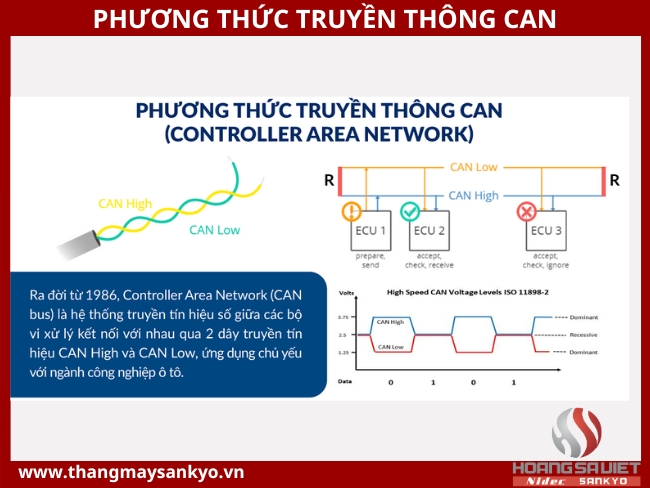
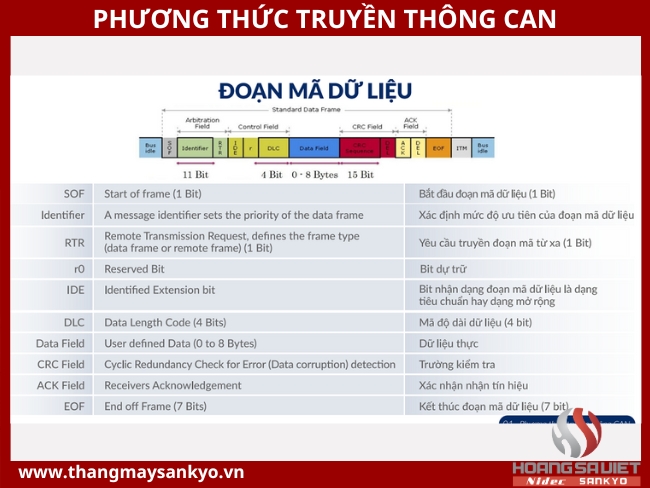
According to Mr. Nguyen Duc Hanh , the CAN data transmission method , initially used mainly in the automobile industry, has quickly expanded its application to many other industries, including the elevator sector. machine. Based on the CAN data transmission method, many different communication protocol development trends have emerged, and among them, CANopen is an outstanding open communication protocol.
CANopen data transmission system in elevators
The CANopen Association, founded in 1994 in Germany, plays an important role in connecting and gathering businesses that use CAN communication methods according to CANopen standards.
CANopen is a device profile description and communication protocol applied to embedded systems integrated in the field of automation. In the OSI architecture, CANopen implements the top layers and includes the network layer. The CANopen standard includes an addressing scheme, a series of small communication protocols, and an application layer defined by the device configuration. Communication protocols support network management, device monitoring, and inter-node communications, including a simple transport layer for message segmentation/de-segmentation. Low-level protocols typically implement data link and physical layers, often using a Controller Area Network (CAN) , however, devices can implement CANopen configurations with a variety of communication media such as Ethernet. Powerlink, EtherCAT.
This has created a model for applying CAN data transmission systems in many diverse fields such as healthcare, aircraft control, ships, especially in the elevator industry,...
Simply, when the CAN data transmission method complies with the CANopen Association standard, we call it CANopen.
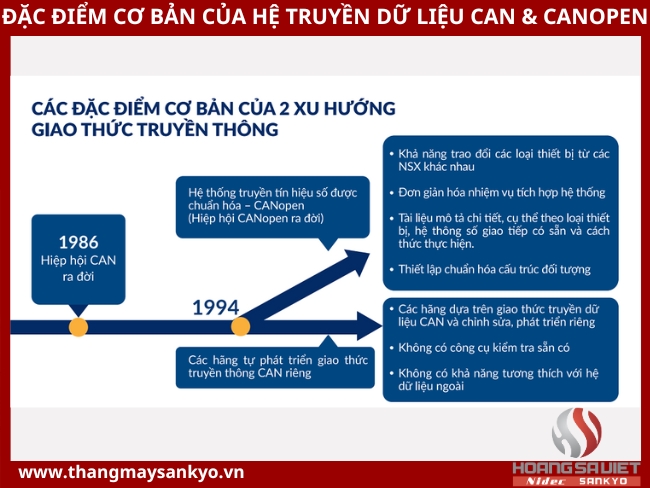
When integrating CAN into their applications, businesses in the research and manufacturing sectors often face the challenge of developing their own language and rules systems, as well as limited testing capabilities due to There are no off-the-shelf testing tools and limited compatibility with data from external sources, resulting in reduced replacement of equipment and components.
Meanwhile, following the CANopen standard, businesses can find a "collection" of partners and suppliers, sharing a common "language", helping to reduce difficulties and optimize the process. integration program.
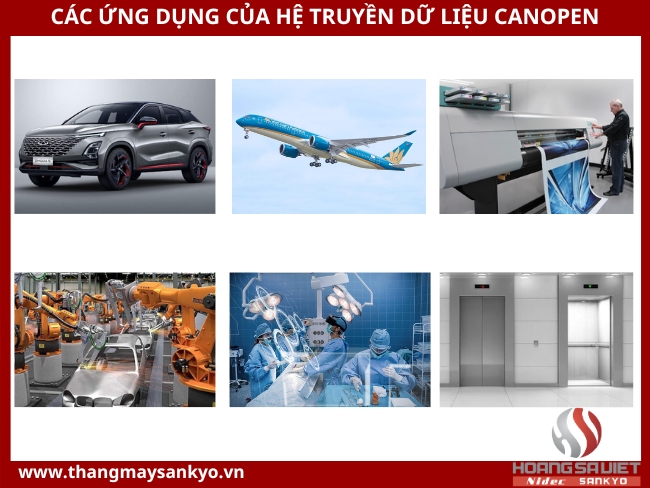

The CANopen data transfer protocol is not only a standardization that every business can use, but also an opportunity for companies to research and develop their own application technology. This opens up the potential for excellent and innovative product development and innovation through research investment, new discoveries and advancements.” That is the view expressed by Dr. Nguyen Duc Hanh shared at the Conference.
APPLICATION OF CAN AND CANOPEN DATA TRANSMISSION SYSTEM IN ELEVATORS - DEVELOPMENT TREND OF ELEVATOR INDUSTRY
-
The CAN data transmission system is commonly used for elevators because of the following advantages: Elevator data is a simple, short signal (contacts, encoder, temperature...) so time takes up the transmission line. fast
-
The CANopen data transmission system has been applied to the elevator industry since 2003. Up to now, many businesses with different types of equipment have become members.
Expanding the dialogue from the CAN data transmission method and the CANopen standard, Dr. Nguyen Duc Hanh gave an overview of the inevitable development trend in the elevator industry: the synchronous development of two directions and the lasting.
This trend is described as being "open" to the general public and "closed" to specialized niches. According to Dr. Nguyen Duc Hanh , for the current large and potential global elevator market, applying a common standard like CANopen brings many benefits to everyone in the elevator market.
- For society: Reduce production costs, reduce total social waste.
- For consumers: Access to cheap products, easy and convenient shopping.
- For businesses: Create close links into a sustainable ecosystem.
However, along with the opportunities that this open trend brings, Dr. Nguyen Duc Hanh also emphasized the challenges when all businesses follow a common standard without investing in new research and development.
|
OPPORTUNITY |
CHALLENGE |
|
Reduce production costs, reduce total social waste |
Reduce incentives for businesses to invest in research and development of new technologies if CANopen is applied |
|
Society uses products that are cheap, easy and convenient to buy |
Society does not have more optimal products to meet special needs in the future |
|
Businesses are closely linked together to form a sustainable ecosystem |
Based on these profound analyzes, Dr. Nguyen Duc Hanh has summarized two simultaneous and sustainable development trends of the elevator industry as well as the global industry.
- "Open" trend: Popular technologies and applications will move towards common standards, to meet the common needs of society and bring benefits to the majority. This is a suitable direction for mid-range, small and medium-sized businesses, targeting a diverse customer base.
- "Closed" trend: Technologies with high requirements, superior applications such as elevators for super high-rise buildings, super-speed elevators, with special design and transmission technology. This is a guide for the leading enterprise group, playing a pioneering role in the elevator industry, with the hope of introducing new inventions and promoting the comprehensive development of the industry.
“Hoang Sa Viet Elevator - Always with you on every high floor!”
HOANG SA VIET ELEVATOR - LEADING PRESTIGIOUS ELEVATOR COMPANY IN VIETNAM
Consulting Specialist: 0942.222.075 Head Office: 184/20 Le Dinh Can, Tan Tao Ward, City. HCM Hanoi headquarters: No. 229, D. Van Tri, Van Noi, Dong Anh, Hanoi Website: thangmaysankyo.vn Email: hungpham@hoangsaviet.com



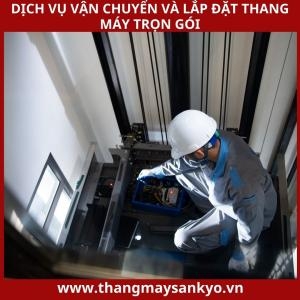
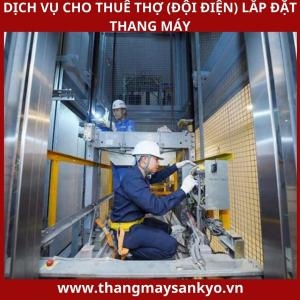
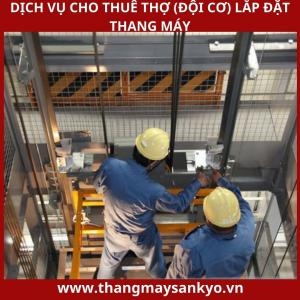

.png)
.png)

.png)












